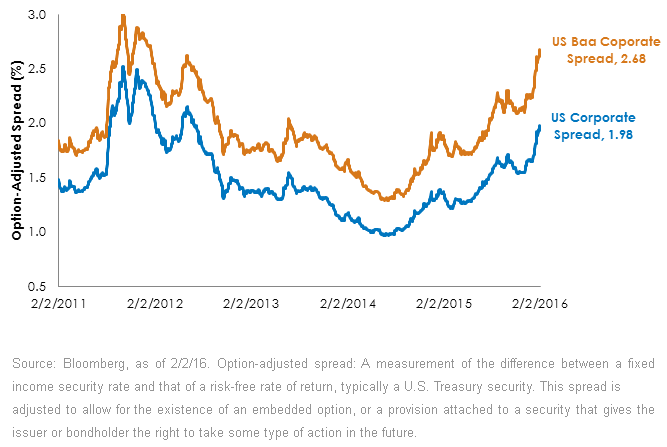U.S. Fixed Income: Give Them Some Credit


 At that time, the money and bond markets were dealing with negative news coming out of the eurozone, as fears of Greece leaving the single currency and the potentially negative ramifications associated with such an event were dominating the newswires. With IG spreads at such wide levels some four to five years later, it is natural to wonder what is behind this latest move. In fact, from a historical perspective, Baa spreads are now at readings that have only been witnessed a few times over the last 20 years. The average yield for an investment-grade corporate bond is more than double the yield of a similar-maturity Treasury.1 This has happened only twice before: during the 2008 financial crisis and the aforementioned 2011–2012 period. Typically in the past, current levels would raise a red flag that a potential recession was looming, but as we saw in the 2011–2012 period, a one-sided “risk off trade” can also be a powerful force.
So where do we stand this time around? We believe the widening in spreads, especially over the last month or so, reflects increasing investor concerns about developments abroad and how they may ultimately impact the U.S. economy. Although we do not envision any renewed momentum for the U.S. expansion, we do expect the domestic economy to avoid a recession and continue to muddle through around the +2% growth threshold. In fact, the case could be made that the current landscape within the IG market has “discounted” quite a bit of negative news already. The recent rate cut from the Bank of Japan and the expectation that China’s policy makers will succeed in avoiding too hard of a landing are two important factors in our base case. In addition, as European Central Bank (ECB) president Mario Draghi stated in his “Whatever It Takes” speech in July 2012, the ECB looks like it will deliver another round of policy easing at its next meeting in March.
Against this backdrop, we believe IG corporates offer fixed income investors an opportunity to increase credit allocations within their core and core plus fixed income portfolios.
1Source: Bloomberg.
At that time, the money and bond markets were dealing with negative news coming out of the eurozone, as fears of Greece leaving the single currency and the potentially negative ramifications associated with such an event were dominating the newswires. With IG spreads at such wide levels some four to five years later, it is natural to wonder what is behind this latest move. In fact, from a historical perspective, Baa spreads are now at readings that have only been witnessed a few times over the last 20 years. The average yield for an investment-grade corporate bond is more than double the yield of a similar-maturity Treasury.1 This has happened only twice before: during the 2008 financial crisis and the aforementioned 2011–2012 period. Typically in the past, current levels would raise a red flag that a potential recession was looming, but as we saw in the 2011–2012 period, a one-sided “risk off trade” can also be a powerful force.
So where do we stand this time around? We believe the widening in spreads, especially over the last month or so, reflects increasing investor concerns about developments abroad and how they may ultimately impact the U.S. economy. Although we do not envision any renewed momentum for the U.S. expansion, we do expect the domestic economy to avoid a recession and continue to muddle through around the +2% growth threshold. In fact, the case could be made that the current landscape within the IG market has “discounted” quite a bit of negative news already. The recent rate cut from the Bank of Japan and the expectation that China’s policy makers will succeed in avoiding too hard of a landing are two important factors in our base case. In addition, as European Central Bank (ECB) president Mario Draghi stated in his “Whatever It Takes” speech in July 2012, the ECB looks like it will deliver another round of policy easing at its next meeting in March.
Against this backdrop, we believe IG corporates offer fixed income investors an opportunity to increase credit allocations within their core and core plus fixed income portfolios.
1Source: Bloomberg. Important Risks Related to this Article
Fixed income investments are subject to interest rate risk; their value will normally decline as interest rates rise. In addition, when interest rates fall, income may decline. Fixed income investments are also subject to credit risk, the risk that the issuer of a bond will fail to pay interest and principal in a timely manner or that negative perceptions of the issuer’s ability to make such payments will cause the price of that bond to decline.


